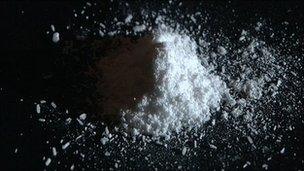'New drugs' offset cocaine and heroin gains, says UN
- Published

Mephedrone is among the "new drugs" sold as "legal highs"
Gains made in tackling global use of cocaine and heroin are being offset by rising consumption of synthetic and prescription drugs, the UN says.
In its annual report, the UN Office on Drugs and Crime (UNODC) said that in Europe, seizures of new psychoactive drugs had been growing.
A number of new synthetic compounds have emerged, the agency said.
These were commonly marketed as "legal" substitutes for drugs like cocaine or ecstasy, it said.
"Every year new products, not under control, are manufactured to supply an increasingly diversified demand for psychoactive substances," the report says.
These include synthetic drugs, as well as drugs based on cannabis, cocaine and opiates.
The drugs are often designed to evade regulations or law enforcement, or to replace drugs that are being supplied in lesser quantities, the UN said.
Some contain unregulated substances and are known as "legal highs".
In addition, the non-medical use of prescription drugs was reported to be spreading in developed and developing countries, the UN said.
In Europe, which the UN described as among the most "innovative" regions for new drugs, 40 new substances were notified in the European early-warning system in 2010, compared to 24 in 2009.
The seized drugs included piperazines, cathinones, synthetic cannabinoids, tryptamines and phenethylamines.
Piperazine was developed for the treatment of parasitic worms and as an anti-depressant. Derivatives of piperazine are often sold as ecstasy.
Other examples of "new drugs" are mephedrone, often touted as a legal alternative to amphetamine or cocaine, and "spice", a synthetic product that emulates the effect of cannabis.
Other developments identified in the UN report for 2010 include:
a "significant" fall in potential cocaine manufacture, due to a fall in cocaine production in Colombia that offset increases in Peru and Bolivia
a small increase in global opium poppy cultivation from 2009-2010, driven by rising cultivation in Burma. Opium poppy production fell, due to a disease in opium poppy plants in Afghanistan
seizures of cocaine and cannabis resin were shifting away from the main consumer markets to source regions
Overall, the UN estimates that between 149 and 272 million people around the world used illicit substances in 2009.
In recent years, stable downward trends in heroin and cocaine use have contrasted with an increase in the use of ATS (amphetamine-type stimulants), the UN says.
- Published23 June 2010